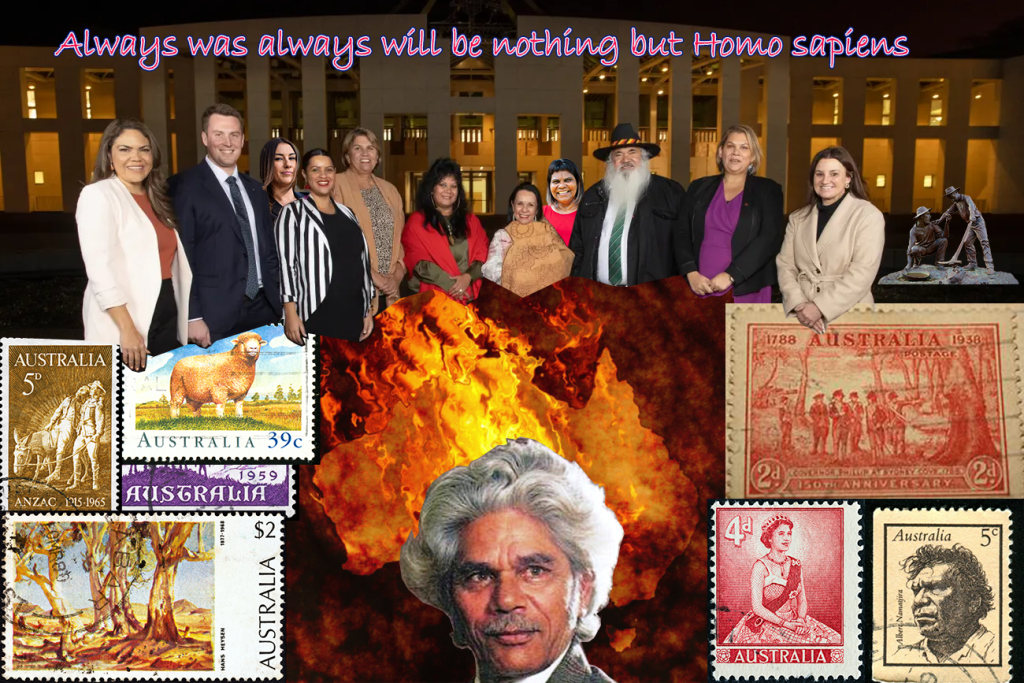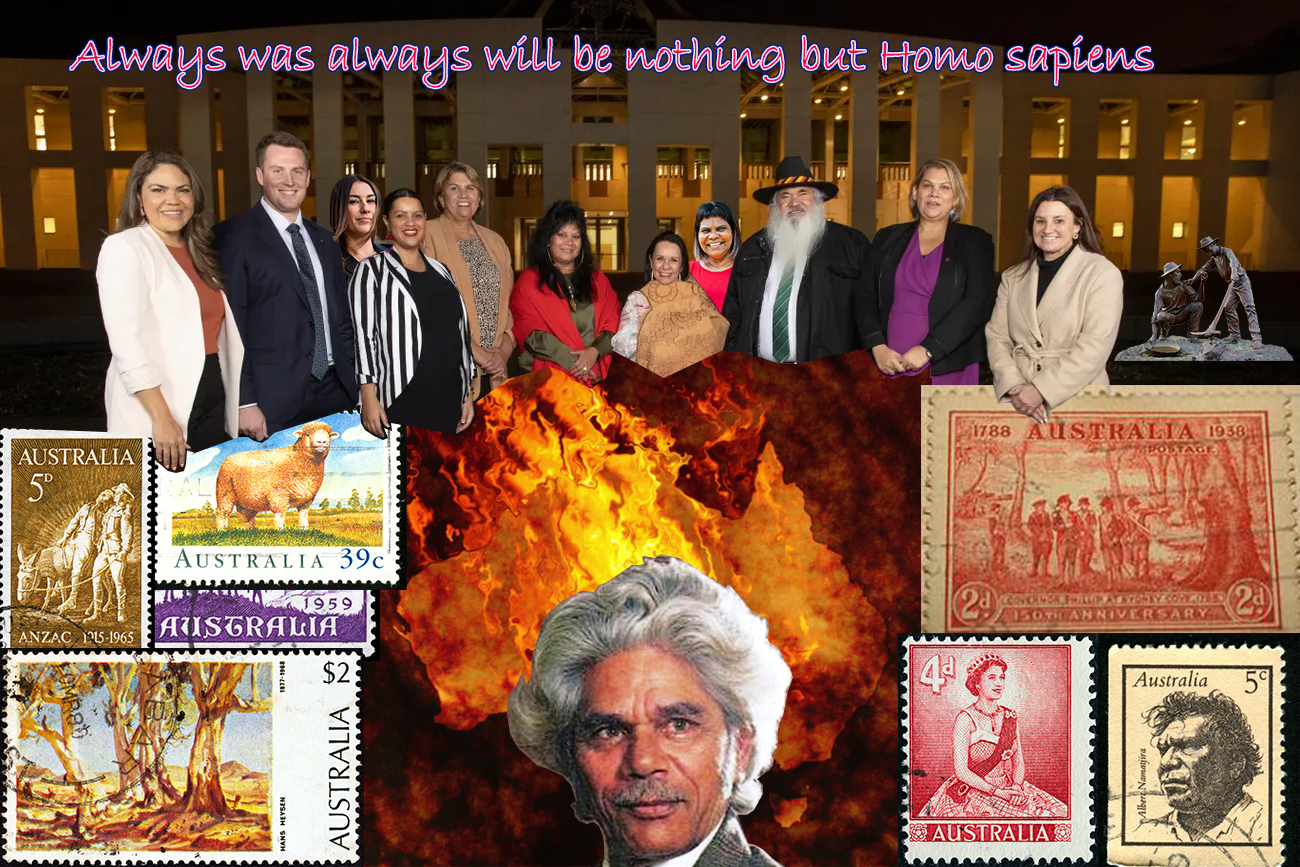Race is a social construct – the colour of your skin does not make you a blackfella, politician or not!

A cultural personal identity means nothing in the greater scheme of things and flagging attention to individual cultural personal identity has no place in the Australian parliament.
‘Indigenous parliamentarian’ is said to be a member of the Australian parliament who identifies as an Aboriginal or Torres Strait Islander or as having Aboriginal or Torres Strait Islander ancestry.
The place we come from is not explained by the colour of our skin, our cultural heritage, our ancestral heritage, our gender, our sexual preference, our age, where we lived or what language we speak.
“Dark Skinned Africans” gave rise to all the human species known as Homo sapiens. Genetic diversity was given to the Homo sapiens species by natural law.
Mixed-ethnicity ancestry, a worldwide fact of the total human population does not uniquely translate to any specific racial identity. Race is a social construct and society’s meander of who is classified as ‘black’ or ‘white’ or ‘coloured’ has changed over time.
Skin colour, eye colour, hair texture, physical features, intelligence, are not inheritable traits exclusive to any one designated group of human beings.
Andrew David Kennedy, born in Ulverstone, Tasmania, on 20 March 1940, was of local native descent. His great, great, great, grandfather is said to be Manalargenna (1775-1835), a chief of a northern tribe in Northern Tasmania. David was educated at the University High School in Melbourne and then the University of Melbourne. After graduation he became a teacher in Victorian state schools.
David Kennedy’s five generations of mixed blackfella, whitefella genealogy was unknown at the time of his election as a Labor member to the House of Representatives at the Bendigo by-election in 1969. Later David Kennedy was elected as a Victorian State parliamentarian. He did not self-identify as ‘Aboriginal’ or ‘Indigenous’ at that time. His elder brother Cyril James Kennedy was a Victorian state parliamentarian, a member of the Legislative Council from 1979 to 1992.
Around the year 2013 the Australian Electoral Commission introduced a training program to get more ‘indigenous’ people into the parliament. Why? At whose beckoning?
The 45th Australian Nation Parliament included five Indigenous parliamentarians. Three senators and two members of the House of Representatives. Three females and two males.
In June 2021, the 46th Australian Nation Parliament included six members, four females and two males, who identified as being Indigenous or as having Indigenous heritage. Four senators and two members in the House of Representatives.
The 47th Australian Nation Parliament included eleven members, eight females and two males, who identified as being First Nations politicians or as having Indigenous ancestry. Eight senators and three members in the House of Representatives. The Hon Linda Burney MP, Member for Barton was sworn in as Minister for Indigenous Australians.
So in the year 2022 there were 11 Homo sapiens who have been elected to the Australian parliament who claim First Nations cultural identity. None are ‘full blood’ local native tribesmen. All represent ‘their’ people, 3% of population over the remaining 97% of Australian citizens. Rightly respected for her courage and her overall views on First Nations people, Jacinta Price gave an emotional and meaningful maiden speech, but her dress confirmed the identity of who she is there to represent first. It is noted that Jacinta Price is now known as Jacinta Nampijinpa Price in much media and introduction.
The Queensland federal electorate of Bonner is named in Neville Bonner’s honour.
It is widely acclaimed that Neville Thomas Bonner was the first ‘Aborigine’ to be elected to the Australian parliament. In his maiden speech he declared “I am the first member of my race to participate in parliamentary proceedings“.
Neville Bonner identified as member of a socially constructed ‘Aboriginal Race’. David Kennedy did not.
Senator Neville Thomas Bonner had mixed ethnicity genealogy, part blackfella, part whitefella, but claimed to be Aboriginal as that was his childhood lived experience. Being ‘part of the Aboriginal race’ was the foremost part of his adult and political identity. In his traditional tribe system members did not ask questions. They listened. They understood what the elders were telling them because the elders knew all and punishment was harsh if you disobeyed.
Neville was born in 1922, romantically stated under a palm tree on a government-issued blanket on a small island in the Tweed River in New South Wales. His mother, Julia, romantically stated was born under a big old pine tree, she was of local native genealogy and his father, Henry Kenneth Bonner, was an Englishman who had jumped ship. His parents separated before he was born. When young Neville had black hair, hazel brown eyes, and dark skin pigmentation. His elder brother Henry, born to the same parents, reportedly had blonde hair, blue eyes, and fair skin pigmentation.
While living on an Aboriginal Reserve on Ukerebagh Island his mother had another son. Some years later his mother moved with her children to Lismore and had another three children with an local native named Frank Randall. Eva, Frankie, who died as a child, and Jim. Neville witnessed frequent acts of violence against his mother at Frank’s hands. His mother died when he was 10 years old and his grandmother who took on the mothering role for him and his younger brother died three years later. His younger sister went with her father to an island in the Maclean River. His eldest brother was looking after himself in an ‘Aboriginal’ community outside of Rockhampton.
Neville Bonner was an ‘Aboriginal Race’ activist who held some conservative political views.
In the 1970 senate election Neville Bonner was happy to be third on the Liberal Party senate ticket and was not elected. After self-promoting media in 1971, he was parachuted into the Australian Senate by the Liberal Party to fill a casual vacancy for Queensland. He stated that in the chamber of parliament he was treated as an equal. But he felt he was seen as a lesser person than others in the parliament. He had an all-consuming burning desire to help his ‘own race’ of people, he called the “first Australians” making up 2% of the population at that time.
He stated that “All money that’s allocated for so-called Aboriginal advancement – 70% of it goes into administrative costs. And most of those administrative costs go to non-Aboriginal people. 30% gets down to what it should be”. Nothing has changed from then until now!
In his maiden speech in the senate Neville Bonner discussed his desire to have the boomerang given copyright exclusively reserved for Aboriginal use. To stop others from exploiting ‘Aboriginal art’ on cheap synthetic copies.
On 20 February 1975 the senate unanimously adopted the following resolution, a motion moved by Senator Neville Thomas Bonner:
“That the senate accepts the fact that the indigenous people of Australia, now know as Aborigines and Torres Strait Islanders, were in possession of this entire nation prior to the 1788 First Fleet landing at Botany Bay, urges the Australian government to admit prior ownership by the said indigenous people, and introduce legislation to compensate the people now known as Aborigines and Torres Strait Islanders for dispossession of their land.”
In 1979, Neville Bonner was named Australian of the Year in recognition of his activism for Indigenous rights and in 1984 he was appointed an Officer of the Order of Australia.
Neville Bonner was a Liberal Party senator for 12 years and voted against the Liberal Party no less than on 34 occasions. In the 1983 senate election he refused to be positioned in an ‘unwinnable’, third on the Liberal Party ticket, and resigned from the Liberal Party. He stood for election as an independent and was not re-elected to the senate. The Liberal Party made him a life member twice. Once in 1978 and after re-joining in 1996 a second time in 1998.
In 1983 the Hawke government appointed Neville Bonner to the board of directors of the Australian Broadcasting Corporation a position he held until 1991.
In his “How Dare You” speech at the Constitutional Convention he said “…I have had the very good luck to have great wealth, to have been so well educated in your schools and universities. I ask you, what reason do you have now in 1998 to tell the Indigenous people that we must accept what you have decided about our country again?”.
Neville Bonner ended his “How Dare You” speech by singing a mourning song in local native Jagera language.
Neville Bonner died in Ipswich in 1999 and was given a state funeral at St Stephen’s Presbyterian Church, Ipswich.
We need less ‘own race’ activists in our parliament and more people who love their country Australia and all the people of her nation.
